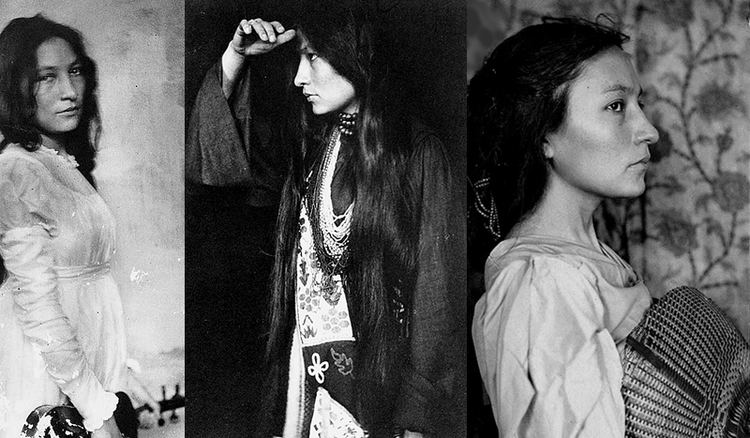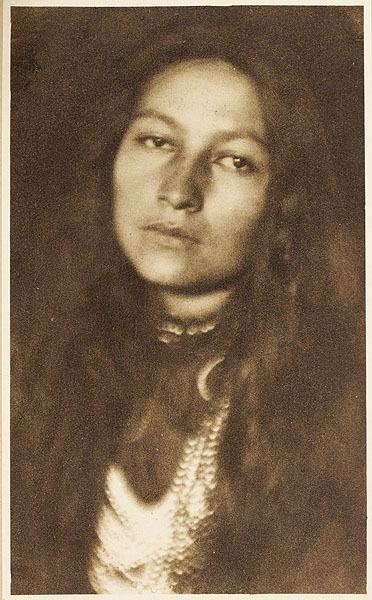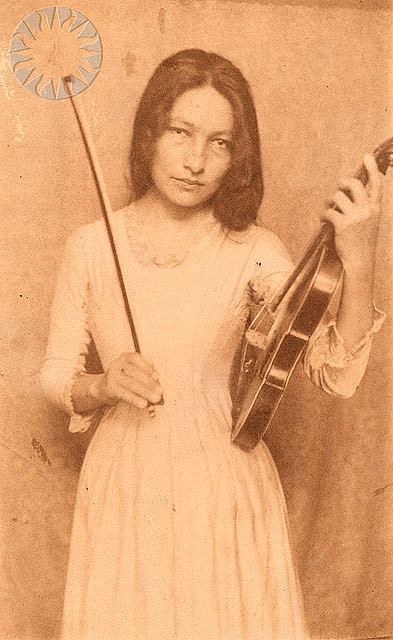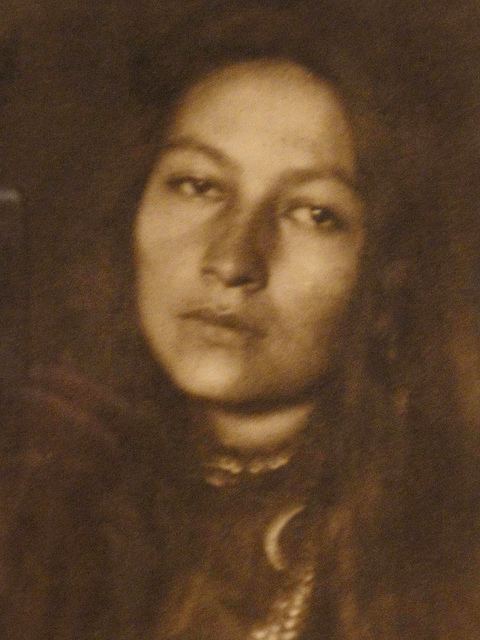Role Writer | Name Zitkala Sa | |
 | ||
Other names Gertrude Simmons Bonnin Occupation Writer, editor, musician, teacher and Native American activist Known for Co-composed the first American Indian opera, founded the National Council of American Indians, wrote books and magazine articles Employer Books American Indian Stories, Old Indian Legends, Impressions Of An Indian Ch, Dreams and thunder, Dance in a Buffalo Skull | ||
Native name Zitkala-Sa, "Red Bird" Similar Sarah Winnemucca, Sitting Bull, Pauli Murray Died January 26, 1938 (aged 61) Washington, DC | ||
Zitkala sa aka gertrude simmons bonnin
Zitkála-Šá (1876–1938) (Lakota: pronounced zitkála-ša, which translates to "Red Bird"), also known by the missionary-given name Gertrude Simmons Bonnin, was a Sioux (Yankton Dakota) writer, editor, musician, teacher and political activist. She wrote several works chronicling her youthful struggles with identity and pulls between the majority culture and her Native American heritage. Her later books in English were among the first works to bring traditional Native American stories to a widespread white readership.
Contents
- Zitkala sa aka gertrude simmons bonnin
- Memories of childhood by zitkala sa and bama part 1
- Early life and education
- Marriage and family
- Literary career
- American Indian Stories
- Old Indian Legends
- Oklahomas Poor Rich Indians
- Articles for American Indian Magazine
- Making of an opera
- Political activism
- Death and legacy
- Writings by Zitkala Sa
- Scores
- References

Working with American William F. Hanson, Zitkala-Ša wrote the libretto and songs for The Sun Dance Opera, (1913), the first American Indian opera. (It was composed in romantic style based on Sioux and Ute themes.)

She was a co-founder of the National Council of American Indians in 1926 to lobby for rights to United States citizenship and civil rights. Zitkala-Ša served as its president until her death in 1938. Her life has been recorded in the biography Red Bird, Red Power: The Life and Legacy of Zitkála-Šá (Norman: University of Oklahoma Press, 2016).

Memories of childhood by zitkala sa and bama part 1
Early life and education

Zitkála-Šá was born on February 22, 1876 on the Yankton Indian Reservation in South Dakota. She was raised by her mother, Ellen Simmons, whose Dakota name was Thaté Iyóhiwiŋ (Every Wind or Reaches for the Wind). Her father was a European-American man named Felker, who abandoned the family while Zitkala-Ša was very young.

For her first eight years, Zitkála-Šá lived on the reservation. She later described those days as ones of freedom and happiness, safe in the care of her mother's people and tribe. In 1884, when Zitkala-Ša was eight, missionaries came to the Yankton Reservation. They recruited several of the Yankton children, including Zitkala-Šá, taking them for education to the White's Manual Labor Institute, a boarding school in Wabash, Indiana. This training school was founded by Quaker Josiah White for the education of "poor children, white, colored, and Indian," with the goal of helping them advance in society.
Zitkála-Šá attended the school for three years until 1887. She later wrote about this period in her work, The School Days of an Indian Girl. She described both the deep misery of having her heritage stripped away, when she was forced to pray as a Quaker and cut her traditionally long hair, and the contrasting joy of learning to read and write, and to play the violin.
In 1887 Zitkála-Šá returned to the Yankton Reservation to live with her mother. She spent three years there. She was dismayed to realize that, while she still longed for the native Sioux traditions, she no longer fully belonged to them. In addition, she thought that many on the reservation were conforming to the dominant white culture.
In 1891, wanting more education, Zitkála-Šá decided at age fifteen to return to White's Manual Labor Institute. She planned to gain more through education than becoming a house-keeper, as the school anticipated girls would do. She studied piano and violin, and started to teach music at White's when the teacher resigned. In 1895 Zitkala-Sa was awarded her first diploma. She gave a speech on women's inequality, which received high praise from the local paper.
Though her mother wanted her to return home after graduation, Zitkála-Šá decided to attend Earlham College in Richmond, Indiana, where she received a scholarship in 1895. Higher education for women was quite limited at the time. Though initially feeling isolated and uncertain among her predominantly white peers, she soon proved her oratorical talents again with a speech entitled "Side by Side" in 1896. During this time, she began gathering Native American legends, translating them first to Latin and then to English for children to read. In 1897, however, six weeks before graduation, she was forced to leave Earlham College due to ill health.
From 1897 to 1899 Zitkala-Ša played violin with the New England Conservatory of Music in Boston.
In 1899 she took a position at Carlisle Indian Industrial School in Pennsylvania, where she taught music to the children and conducted debates on the treatment of Native Americans. In 1900 she played violin at the Paris Exposition with the school's Carlisle Indian Band. In the same year she began writing articles on Native American life, which were published in such national periodicals as Atlantic Monthly and Harper's Monthly. Also in 1900 Zitkala-Ša was sent by Carlisle's founder, Colonel Richard Henry Pratt, to the Yankton Reservation for the first time in several years to recruit students.
She was greatly dismayed to find that her mother's house was in disrepair, her brother's family had fallen into poverty, and that white settlers were beginning to occupy lands allotted to the Yankton Dakota under the Dawes Act of 1877. Upon returning to the Carlisle School, she came into conflict with its founder, as she resented his rigid program of assimilation into dominant white culture and the limitations of the curriculum. It prepared Native American children only for low-level work, assuming they would return to rural cultures. In 1901 Zitkala-Ša was dismissed. That year she had published an article in Harper's Monthly describing the profound loss of identity felt by a Native American boy after undergoing the assimilationist education at the school.
Concerned with her mother's advanced age and her family's struggles with poverty, she returned to the Yankton Reservation in 1901.
In 1901 Zitkála-Šá began collecting stories from Native Americans on the reservation to publish in Old Indian Legends, commissioned by the Boston publisher Ginn and Company. She took a job as a clerk at the Bureau of Indian Affairs at Standing Rock Indian Reservation.
Marriage and family
In 1902 she met and married Captain Raymond Talefase Bonnin, who was culturally Yankton and was mixed-race, with one-quarter Yankton Dakota ancestry.
Soon after their marriage, Captain Bonnin was assigned to the Uintah-Ouray reservation in Utah. The couple lived and worked there with the Ute people for the next fourteen years. During this period, Zitkala-Ša gave birth to the couple's only son, Raymond Ohiya Bonnin.
Also during this period, Zitkála-Šá met American professor and composer William F. Hanson, who taught music at Brigham Young University in Utah. Together, in 1910, they started their collaboration on the music for The Sun Dance Opera, for which Zitkala-Sa wrote the libretto and songs. She based it on sacred Sioux ritual, which the federal government prohibited the Ute from performing on the reservation. The opera premiered in Utah in 1913, with dancing and some parts performed by the Ute; lead singing roles were filled by non-natives. It was the first opera to be co-authored by a Native American. It debuted to high local praise.
Literary career
Zitkála-Šá had a fruitful writing career, with two major periods. The first period was from 1900 to 1904, when she published legends collected from Native American culture, as well as autobiographical narratives. She continued to write during the following years, but she did not publish. These unpublished writings, along with others including the libretto of the Sun Dance Opera, were collected and published posthumously in 2001 as Dreams and Thunder: Stories, Poems, and the Sun Dance Opera by P. Jane Hafen.
Zitkála-Šá's articles in the Atlantic Monthly were published from 1900 to 1902. They included, "An Indian Teacher Among Indians," published in Volume 85 in 1900. Included in the same issue were "Impressions of an Indian Childhood" and "School Days of an Indian Girl". All of these works were autobiographical in nature, describing in great detail her early experiences both on the reservation and her later conflict in struggling with assimilation with the dominant American culture.
Zitkála-Šá's other articles ran in Harper's Monthly. "Soft-Hearted Sioux" appeared in the March 1901 issue, Volume 102, and "The Trial Path" in the October 1901 issue, Volume 103. She also wrote "A Warrior's Daughter", published in 1902 in Volume 4 of Everybody's Magazine. These works also were largely autobiographical in nature, though some recounted stories of people she knew or taught, in addition to her own personal story.
In 1902 Zitkála-Šá published "Why I Am a Pagan" in Atlantic Monthly, volume 90,. It was a treatise on her personal spiritual beliefs, in which she countered the trend of the time that suggested Native Americans readily adopted and conformed to the Christianity forced on them in schools and public life.
Much of her work is characterized by its liminal nature: tensions between tradition and assimilation, and between literature and politics. These tensions are expressed particularly in her autobiographical works. In her well-known American Indian Stories, for example, she both expresses a literary account of her life and delivers a political message. The narrative expresses her tension between wanting to follow the traditions of the Yankton Dakota while being excited about learning to read and write, and being tempted by assimilation. This tension has been described as generating much of the dynamism of her work.
The second period was from 1916 to 1924. During this period, Zitkala-Ša concentrated on writing and publishing political works. She and her husband had moved to Washington, D.C., where she became politically active. She published some of her most influential writings, including American Indian Stories (1921), with the Hayworth Publishing House. She co-authored Oklahoma’s Poor Rich Indians: An Orgy of Graft and Exploitation of the Five Civilized Tribes, Legalized Robbery (1923), an influential pamphlet, with Charles H. Fabens of the American Indian Defense Association and Matthew K. Sniffen of the Indian Rights Association. She also created the Indian Welfare Committee of the General Federation of Women’s Clubs, working as a researcher for it through much of the 1920s.
American Indian Stories
American Indian Stories is a collection of childhood stories, allegorical fiction, and an essay, including several of Zitkála-Šá's articles that were originally published in Harper's Monthly and Atlantic Monthly. It was first published in 1921 and served as an account of the hardships which she and other Native Americans encountered when they were brought to missionary and manual labor schools designed to “civilize” them. The autobiographical writings described her early life on the Yankton Reservation, her years as a student at White's Manual Labor Institute and Earlham College, and the time she spent teaching at Carlisle Indian Industrial School.
Her autobiography contrasted the charm of her early life on the reservation with the “iron routine” which she found in the assimilation boarding schools. Zitkala-Ša wrote: “Perhaps my Indian nature is the moaning wind which stirs them [schoolteachers] now for their present record. But, however tempestuous this is within me, it comes out as the low voice of a curiously colored seashell, which is only for those ears that are bent with compassion to hear it."
Old Indian Legends
Commissioned by the Boston publisher Ginn and Company, Old Indian Legends (1901) was a collection of stories which she had gathered from various tribes. Directed primarily at children, the collection was an attempt both to preserve Native American traditions and stories in print and to garner respect and recognition for those traditions from the dominant white culture.
Oklahoma's Poor Rich Indians
One of Zitkála-Šá's most influential pieces of political writing, "Oklahoma's Poor Rich Indians" was published in 1923 by the Indian Rights Association. The article exposed several American corporations that had been working systematically through such extra-legal means as robbery and even murder to defraud Native American tribes, particularly the Osage, to their rights to a plot of oil-rich land in Oklahoma. The work influenced Congress to pass the Indian Reorganization Act of 1934, which encouraged tribes to re-establish self-government, including management of their lands, and returned some surplus lands to them as communal property.
Articles for American Indian Magazine
Zitkála-Šá was an active member of the Society of American Indians, which published the American Indian Magazine. From 1918 to 1919 she served as editor for the magazine, as well as contributing numerous articles. These were her most explicitly political writings, covering topics such as the contribution of Native Americans to World War I, land allotment, and corruption within the Bureau of Indian Affairs, the agency within the Department of Interior that oversaw American Indians. Many of her political writings have since been criticized for favoring assimilation. She called for recognition of Native American culture and traditions, while also advocating US citizenship rights to bring Native Americans into mainstream America. She believed this was how they could gain political power.
Making of an opera
In 1910 Zitkala-Ša began collaborating with American composer William F. Hanson, who taught at Brigham Young University. She wrote the libretto and songs. She also played Sioux melodies on the violin, and Hanson used this as the basis of his music composition.
In February 1913, the premiere performance of The Sun Dance Opera was presented at Orpheus Hall in Vernal, Utah. The production featured members of the Ute Nation, who lived on the nearby Uintah and Ouray Indian Reservation. It was significant in its shift from Native American oral musical tradition to a written one. Its debut was met with critical acclaim. Few works of Native American opera have dealt with Native American themes so exclusively since.
In 1938 the New York Light Opera Guild premiered The Sun Dance Opera at The Broadway Theatre as its opera of the year. Its publicity credited only William F. Hanson as composer.
Political activism
Zitkála-Šá was highly politically active throughout most of her adult life. During her time on the Uintah-Ouray reservation in Utah, she joined the Society of American Indians, a progressive group formed in 1911. It was dedicated to preserving the Native American way of life while lobbying for the right to full American citizenship. Zitkala-Ša served as the SAI's secretary beginning in 1916. She edited its journal American Indian Magazine from 1918 to 1919. Since the late 20th century, activists have criticized the SAI and Zitkala-Ša as misguided in their strong advocacy of citizenship and employment rights for Native Americans. Such critics believe that Native Americans have lost cultural identity as they have become more part of mainstream American society.
As the secretary for the SAI, Zitkála-Šá corresponded on its behalf with the Bureau of Indian Affairs. She began to criticize the practices of the BIA, such as their attempt to prohibit Native American children from using their native languages and cultural practices at the national boarding schools. She reported incidents of abuse resulting from children's refusal to pray in the Christian manner. Her husband was dismissed from his BIA office at the Ute reservation in 1916. The couple and their son relocated to Washington D.C, where they thought to find allies.
From Washington, Zitkála-Šá began lecturing nationwide on behalf of the SAI to promote the cultural and tribal identity of Native Americans. During the 1920s she promoted a pan-Indian movement to unite all of America's tribes in the cause of lobbying for citizenship rights. In 1924 the Indian Citizenship Act was passed, granting US citizenship rights to many though not all indigenous peoples.
In 1926 she and her husband founded the National Council of American Indians, dedicated to the cause of uniting the tribes throughout the U.S. in the cause of gaining full citizenship rights through suffrage. From 1926 until her death in 1938, Zitkala-Ša would serve as president, major fundraiser, and speaker for the NCAI. She was the major figure in those years. Her early work was largely disregarded when the organization was revived in 1944 under male leadership.
Zitkála-Šá was also active in the 1920s in the movement for women's rights, joining the General Federation of Women's Clubs in 1921. It was a grassroots organization dedicated to diversity in its membership and to maintaining a public voice for women's concerns. Through the GFWC she created the Indian Welfare Committee in 1924. She catalyzed a government investigation into the exploitation of Native Americans in Oklahoma and the attempts being made to defraud them of drilling rights to their oil-rich lands. Zitkala-Ša was co-author of "Oklahoma's Poor Rich Indians: An Orgy of Graft and Exploitation of the Five Civilized Tribe-Legalized Robbery". The article exposed several corporations that had robbed and even murdered Native Americans in Oklahoma to gain access to their lands.
Its influence contributed to Congressional passage of the Indian Reorganization Act of 1934 under the President Franklin D. Roosevelt administration. He had high-level aides also working on American Indian issues to improve their lives. This legislation was sometimes described as the 'Indian New Deal,' and it encouraged tribes to restore and adopt self-government, along a model of elected representative government. which returned the management of their lands to Native Americans.
In her work for the NCAI in 1924, Zitkála-Šá ran a voter-registration drive among Native Americans. She encouraged them to support the Curtis Bill, which she believed would be favorable for Indians. Though the bill granted Native Americans US citizenship, it did not grant those living on reservations with the right to vote in local and state elections. Zitkala-Ša continued to work for civil rights, and better access to health care and education for Native Americans up until her death in 1938.
Death and legacy
Zitkála-Šá died on January 26, 1938 in Washington, DC at the age of sixty-one. She is buried under the name of Gertrude Simmons Bonnin in Arlington National Cemetery. Since her death the University of Nebraska has reissued many of her writings on Native American culture.
She has been recognized by the naming of a Venusian crater "Bonnin" in her honor. In 1997 she was designated a Women's History Month Honoree by the National Women's History Project.
Writings by Zitkala-Sa
For a more comprehensive listing of all her writings see the American Native Press Archives maintained by the Sequoyah Research Center at the University of Arkansas, Little Rock.
